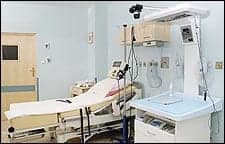In January 2007, the Joint Commission on Accreditation of Healthcare Organizations, or JCAHO, officially shortened its name to “The Joint Commission.” The CCE Prep article in the January 2007 issue of 24×7 reviewed the requirements of The Joint Commission standard EC.6.10. This article will review the requirements of standard EC.6.20.
Each Joint Commission standard is divided into requirements called elements of performance (EP). EC.6.20 has six EPs. Following is a brief description of each EP.
1) Inventory
This EP requires the hospital to establish a current, precise, and unique inventory of all medical equipment managed under the medical equipment program, regardless of ownership. The inventory should consider for inclusion all medical equipment in use at the hospital including hospital-owned and nonhospital-owned equipment (leased, rented, physician-owned, patient-owned, etc). Any medical equipment managed by other vendors should also be considered for inclusion in the medical equipment inventory. The medical equipment inventory should not be restricted to devices included in the medical equipment maintenance program. An accurate and complete inventory is critical for various medical equipment management functions, including tracking of manufacturers’ recalls, documenting the cost of maintenance, replacement planning, scheduling maintenance work, and tracking model-specific and device-specific issues.
 |
| Any medical equipment managed by other vendors should also be considered for inclusion in the medical equipment inventory. |
It is desirable to keep the medical equipment inventory highly accurate, and random samples should be taken periodically to assess the inventory’s accuracy. One method could be to document monthly the number of items that could not be located that are on a monthly preventive maintenance (PM) schedule. The number of “unable-to-locate” items should be low if the inventory listing does not include any items that are not in fact present at the facility. Conversely, items missing from the inventory make themselves apparent because they do not carry either a PM sticker or an equipment control number. Another approach would be to print annually departmental inventories and verify that all items listed are in the hospital by walking through the entire hospital. This would also identify any items in the hospital that are not on the inventory.
2) Performance and Safety Testing
This EP requires the hospital to test all medical equipment for safety and performance before it is initially used in the hospital. This testing should also include non-hospital equipment that is leased, rented, etc.
3) and 4) Maintenance on Life Support and Non-Life Support Equipment
Not too long ago, The Joint Commission considered 95% maintenance completion to be a “pass” for a medical equipment program. In 2004, it discontinued the 95% requirement and added specific “life support” language to the standard EC.6.20. The intent of these changes was to ensure that critical equipment receives priority attention. It requires the organization to separately track and report the maintenance completion of medical equipment in two categories: life support and non-life support. The Joint Commission defines life support equipment as “those devices intended to sustain life and whose failure to perform its primary function, when used according to manufacturer’s instructions and clinical protocol, is expected to result in imminent death in the absence of immediate intervention. Examples include ventilators, anesthesia machines, and heart-lung bypass machines).” Anesthesia ventilators, external pacemakers, intra-aortic balloon pumps, and ventricular assist devices could all be included in the life support category. The hospital should develop a list of life support items based on the above definition and organizational experience.
The 2007 Joint Commission standards do not contain an explicit PM completion requirement. However, based on the scoring guidelines, it would be appropriate to set a goal for an on-time maintenance completion rate for life support equipment at 100%, and the goal for the non-life support equipment at better than 90%. The maintenance completion for life support equipment is scored more stringently than the completion rate for non-life support equipment. It is possible that if maintenance of a single life support device is missed, the survey team could generate an adverse, noncompliance “finding.” However, it has been reported that it is more likely that the surveyors will focus on investigating the gaps in the process that led to the missed PM.
5) Performance Testing of All Sterilizers
This EP requires the hospital to document performance testing of all sterilizers. Sterilizers may be found in surgery, central service, and other departments. Usually, the departments that have sterilizers are responsible for verifying proper sterilization performance and for keeping a record of the testing. Each department’s data must be aggregated and reported.
6) Dialysis
This EP requires the hospital to do chemical and biological testing of the water used in dialysis and to perform other required tests based upon regulations, manufacturers’ recommendations, and hospital experience. If dialysis service is provided on a contract basis, the hospital must ensure that all the proper tests are done and records are maintained.
Arif Subhan, MS, CCE, is a senior clinical engineer, Masterplan, Chatsworth, Calif; and chair, CCE education committee, ACCE. For more information, contact .
Review Questions
1) The Joint Commission standards require that the medical equipment inventory include ___ man- aged under the medical equipment program.
a) Only hospital-owned equipment
b) Only nonhospital-owned equipment
c) Hospital-owned and rented equipment
d) All equipment, regardless of ownership
e) Leased and rented equipment
2) There are ___ elements of performance in The Joint Commission standard EC.6.20.
a) 6
b) 8
c) 10
d) 14
e) None of the above
3) As defined by The Joint Commission, ___ can be classified as life support equipment.
a) Ventilators
b) Anesthesia machines
c) Heart-lung bypass machines
d) Intra-aortic balloon pumps
e) All of the above
4) The elements of performance in The Joint Commission standard EC.6.20 include ___.
a) Establishing a current and accurate inventory of all equipment
b) Completing initial performance and safety testing before use
c) Doing maintenance on life support and non-life support equipment
d) Performance testing of all sterilizers
e) All of the above
5) The Joint Commission standard EC.6.20 requires chemical and biological testing of the water used in dialysis ___.
a) Weekly
b) Monthly
c) Quarterly
d) Annually
e) None of the above
6) The Joint Commission standard EC.6.20 requires a PM completion requirement of ___ for life support equipment.
a) 95%
b) 90%
c) 97%
d) 85%
e) None of the above





